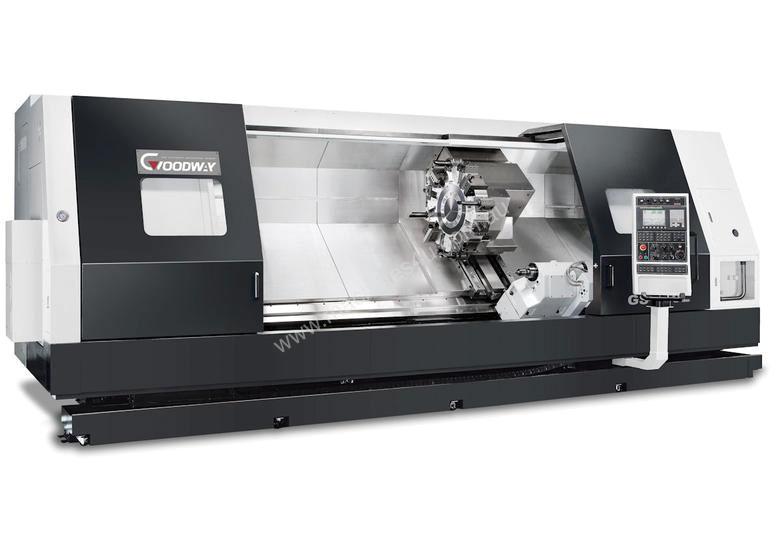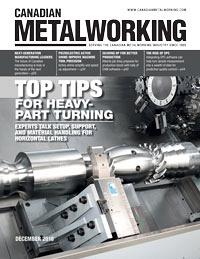Associate Editor
- FMA
- The Fabricator
- FABTECH
- Canadian Metalworking
Top tips for heavy-part turning
Experts talk setup, support, and material handling for horizontal lathes.
- By Lindsay Luminoso
- December 17, 2018
- Article
- Metalworking

When you machine heavy parts, you want to make sure that the setup is good with a strong hold of the part, so it can’t move. Photo courtesy of Kaast Machine Tools.
Turning heavy parts requires some considerations that operators may not need to factor into when turning standard parts, particularly when it comes to horizontal setups. The experts agree that there are a number of tips that all operators should address before putting cutting tool to material.
“There are many things to consider, like part size and length, tolerances, and material being cut,” said Moe Obradovic, sales and applications engineer, Megatel, Mississauga, Ont. “It’s important to look at the specifications of the part and properly prep the CNC machine. If it’s a heavy part, it may be better to put it on a vertical setup, but in most cases, you would stick with the horizontal setup.”
HORIZONTAL LATHES
It’s important to choose the best machine for the job. If a shop has a number of horizontal lathes, Obradovic suggests going with the heaviest machine for particularly heavy parts.
Physical structure of machine design and tuning of spindle drive(s) for heavy-payload and adaptive control capabilities can only benefit,” added John Baresic, application manager, DMG Mori Canada, Mississauga, Ont. “The depth of machining cut is obviously a focus with heavy parts, so having a machine that can take those cuts can be crucial.”
Heavy parts tend to be very expensive parts, and putting them on a turning centre that is not suited for the cutting specifications needed could eventually lead to scrapping damaged or deformed parts. It’s important to assess all parameters before you begin cutting to ensure that the machine is properly suited for the part.
“Heavier machines tend to offer more stability and better cutting performance in heavy-part scenarios,” Obradovic said. “You need that. And when you are dealing with expensive parts, it’s a good idea for a shop to put its most experienced operators on these jobs.”
A horizontal lathe tends to offer better chip management than vertical configurations. A typical horizontal turning centre has a slant bed, so the X axis is on an angle, allowing for a lot of material removal because there is an easy path for the chips to follow down and out of the envelope.
SETUP
“Workholding is a large part of heavy-part turning,” said Cameron Salley, applications engineer, Hurco, Indianapolis, Ind. “It’s not so much about the chuck but rather the jaws that support the part. I would typically recommend a hardened jaw for heavy parts.”
Salley pointed out that once the jaws are machined and ground, they are hardened to make them more stable. In situations like heavy-part turning, the chuck needs to apply a significant amount of clamping force, and hardened jaws will allow clamping force to be transferred onto the part without deforming the jaws.
“When you machine heavy parts, you want to make sure that your setup is good with a strong hold of the part, so it can’t move,” said Bruce DeFuria, CNC machine technician, Kaast Machine Tools, Aldan, Pa. “A good setup ensures you’re going to get the results you want out of it. You can’t get a good part with a poor setup. It never works.”

Heavier machines tend to offer more stability and better cutting performance in heavy-part turning operations. Photo courtesy of Megatel.
SUPPORT
“Machining heavy or long parts almost always requires additional workpiece support via steady rest or tailstock,” said Baresic.
This is echoed by Salley, who explained that sometimes you run into issues when you use a steady rest in conjunction with a live centre. In those cases, especially with larger parts, you can’t put the centre drill hole into the part for the live centre support until the part is already in the machine. You must hold it in place and turn it before you have a chance to put that centre in.
“That’s where you need to use a steady rest to support the part in front of the chuck while leaving the end of the part accessible for a drill or a centre drill to come in and make that pilot hole,” Salley explained. DeFuria noted that when it comes to turning a heavy part, the preferred method is to put it between centres; the headstock would have a dead centre and the tailstock would have a live centre, and trapping the part between these two centres would help keep the part running concentric.
For Baresic, balancing the workpiece is critical to minimize additional and unnecessary stresses on the machine, as well as the stress placed on the cutting tools. This is particularly important when working on a casted part, which requires ensuring that the part is not running terribly out of balance, and if so, counterbalancing it.
“The part is not spinning fast, but you will get momentum moving and that would be a problem,” said DeFuria. “So we must put weight on it, or sometimes they would weld it depending on the part, to try and counteract the weight imbalance, which will negatively affect your cut.”
CUTTING PARAMETERS
“Selecting the correct tools for the specific material being used and adjusting the speeds and feeds accordingly are very important for heavy-part cutting,” said Obradovic.
For the most part, the rotation speed gets slower and the tools get bigger, making the process longer and more expensive. And with the horizontal setup, you’re always fighting gravity, so it’s important to take that into account during setup and programming.
“A lowered-spindle and overall lower-mass-of-gravity machine design is ideal for turning heavy parts,” said Baresic. “High-torque output spindles and thermal stability with liquid cooling are also beneficial.”
Baresic added that on a horizontal setup, left-hand turning tools send cutting forces into the machine bed and give better overall stability, which is important when a mistake could be costly.
MATERIAL HANDLING
The goal of any operator is to take a material block or bar and turn it into a properlyfinished piece. Heavy parts require extra considerations when it comes to material handling. DeFuria noted that you certainly do not want to bump, damage, or drop high-precision components.

On a horizontal setup, left-hand turning tools send cutting forces into the machine bed and give better overall stability. Photo courtesy of Kaast Machine Tools.
“You really want to be very careful at every stage of the handling process,” DeFuria added. “As parts get heavier, everything becomes more important. The rigging you use to pick up the part and the way you handle it can spell disaster. If you get your hand pinched with a small part, it will hurt, but with a big part, you could be headed to the hospital.”
When using a crane, which is common for setting up large parts, you definitely want to make sure the part is secure before you take the crane away. On the flip side, when you are ready to take the part out, make sure the crane is on it and there is a little strain against it before you release it.
“If you are working as a pair, two guys working together or even three, to make sure this part gets in the lathe, everybody must be very detail-oriented and paying attention to what’s going on using the adequate straps,” Salley added. “The straps must be rated well beyond the weight of the part itself. You don’t have that with light parts because you can just set them in there by hand.”
Overall, heavy parts take more time because everything is much more involved. The experts agree that it’s important to go slowly and check on the process every step of the way to ensure that there are no problems leading to a scrapped part, which can be costly in time and money.
Associate Editor Lindsay Luminoso can be reached at lluminoso@canadianmetalworking.com.
DMG Mori, ca-en.dmgmori.com
Hurco, www.hurco.com
Kaast Machine Tools, kaast-usa.com
Megatel, www.megatelcnc.com
About the Author

Lindsay Luminoso
1154 Warden Avenue
Toronto, M1R 0A1 Canada
Lindsay Luminoso, associate editor, contributes to both Canadian Metalworking and Canadian Fabricating & Welding. She worked as an associate editor/web editor, at Canadian Metalworking from 2014-2016 and was most recently an associate editor at Design Engineering.
Luminoso has a bachelor of arts from Carleton University, a bachelor of education from Ottawa University, and a graduate certificate in book, magazine, and digital publishing from Centennial College.
Related Companies
subscribe now


Keep up to date with the latest news, events, and technology for all things metal from our pair of monthly magazines written specifically for Canadian manufacturers!
Start Your Free Subscription- Industry Events
MME Winnipeg
- April 30, 2024
- Winnipeg, ON Canada
CTMA Economic Uncertainty: Helping You Navigate Windsor Seminar
- April 30, 2024
- Windsor, ON Canada
CTMA Economic Uncertainty: Helping You Navigate Kitchener Seminar
- May 2, 2024
- Kitchener, ON Canada
Automate 2024
- May 6 - 9, 2024
- Chicago, IL
ANCA Open House
- May 7 - 8, 2024
- Wixom, MI




















